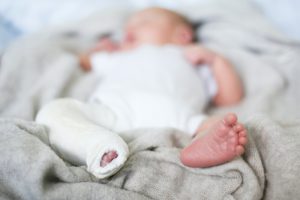 Written by Maureen Hoff
Written by Maureen Hoff
One in every 1,000 babies is born with a congenital birth defect called clubfoot. The medical term is talipes equinovaris, but it is commonly referred to as clubfoot in both the medical world and the general public.
This is a deformity that impacts the muscles and bones of the feet causing them to turn upward and inward toward the ankle bone. It can occur in both feet (bilateral) or one foot (unilateral), and it is twice as prevalent in boys than girls.
While common, there is no known cause of clubfoot. Experts believe that genetics and environment contribute to it.
What issues does clubfoot cause for babies?
While clubfoot can range in severity, the treatment method is similar in all cases. If the foot is not corrected shortly after birth, treatment can be longer and more extensive.
If clubfoot is left completely untreated, the child will have severe issues with mobility, such as walking or running, and it can lead to lifelong pain and disability.
Click here to watch our on-demand class about clubfoot
Treatment for clubfoot
The most successful and widely-used treatment for clubfoot is the Ponseti Method. It is comprised of two phases of treatment: correction through serial casting, and maintenance through brace wear. This minimally-invasive method has a success rate of over 90%.
Casting
A child with clubfoot begins serial casting soon after birth to slowly manipulate their foot into the correct position. The treating doctor gently stretches the foot each week and places a plaster thigh high cast on the leg to hold the foot in the proper position. Each week the old cast is removed, the foot stretched further into the correct position, and a new cast placed. On average a child will need five to six casts before the foot is in the fully corrected position.
Tenotomy
In 80% of cases, a child will need a tenotomy. This is a surgical procedure involving severing the Achilles tendon in order for it to grow and lengthen to allow for more flexibility. After the procedure is complete, the child is placed in their last cast for three weeks before they move to the bracing phase of treatment.
Bracing
After the tenotomy is complete and the final cast removed, the child is placed immediately in a bracing device, often referred to as Boots and Bar (BnB). This device maintains the foot in the correct position to prevent clubfoot relapse. If the child does not wear the BnB or does not follow the recommended bracing schedule, the chances of clubfoot relapse are significantly higher.
The BnB is worn for a graduated schedule, starting at 23 hours for the first three months, and tapering down to 12 hours, or night-time wear. The BnB needs to be worn until age four or five years.
Avoiding surgery
Surgical intervention for clubfoot should always be the last resort treatment option. Surgery can lead to lasting scar tissue and early onset of arthritic feet in adulthood. In many cases, the damage caused by early surgery can never be repaired. The Ponseti method of clubfoot treatment provides a child with the best chance at having fully-functional and pain-free feet into adulthood.
If your baby has been diagnosed with clubfoot, talk with your obstetrician or pediatrician who can help refer you to a pediatric orthopedic surgeon who is trained in the Ponseti Method.
Maureen Hoff is the mother of three girls, the youngest of whom was born with bilateral clubfoot in 2018. She is the author of Clubfoot Chronicles: Tips for Helping your Clubfoot Cutie During Treatment, and the host of the clubfoot themed podcast, A Clubfoot Mom. Maureen is passionate about clubfoot awareness and advocacy, and supporting parents on their child’s clubfoot journey.
Back







